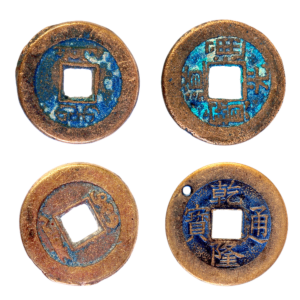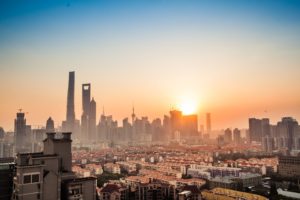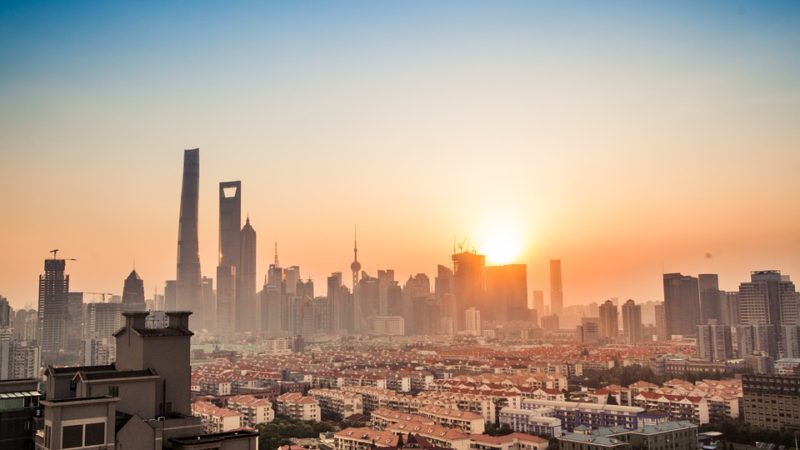We selectively attend to what we believe is true. As the notorious Dan Sullivan has said, “Our eyes only see and our ears only hear what our brain is looking for.”

What’s hiding under the clouds?
With other words, by right, we should all have one or two blind spots. Being aware of them is a first step, however, we should “learn to unlearn” them. In my experience and work with the wealthy of Asia and without wanting to make a political statement here, I believe we in the West don’t know enough about the East – and it would be beneficial for us to change that.
Recently this picture was shared in the international press:

Do you know this group of men? Any of them? Well, they are all Chinese gentlemen in their late 30’s and early 40’s. What do they have in common? Besides being Chinese, they are all extremely successful internet entrepreneurs, and yes, most of them are billionaires. As a matter of fact, only a few hand selected individuals in the West recognize them.
Did you know that Asia is home to the most billionaires with China leading the pack? Two billionaires are “minted” in China every week! In average puttygen download windows , the Chinese billionaire reaches this status 6 years earlier than their U.S. or even 7 years ahead of European peers at age 55.
While certainly much more volatile than the West, the Chinese economy is advancing at a breath taking pace and with unprecedented magnitude. Just have a look at the projects that are about to become reality in the next couple of decades:
People in the West, wake up!
For many Westerners China is still synonymous with the copying or stealing of ideas and the production of low-cost goods with poor quality. The majority of the Western population however has no idea how the modernized China lives and breathes. They will be perfectly surprised by the upcoming next chapter of Chinese economic evolution when innovations, technologies and businesses from China will conquer the US, Europe and the rest of the world.
Do by no means underestimate the rapidly compounding learning curve, the hunger and persistence of the Chinese. Forget the old picture of a Western business subsidy in China with the strong white guy managing herds of local staff, prepare to turn this picture upside down. Businesses from China are preparing to set-up their own hubs in the heart of the “old world”.
The key question for the Chinese is how the ‘old world’ US and European governments are going to deal with this shift of power. Will the West be afraid and attempt to shut the doors or will they embrace the new kids on the block and adapt? With other words: Crisis-Management will be key.
As a long-term student of the Chinese language, I was surprised to learn the word “crisis” – if translated into Chinese – will be 危機 [spoken as “weiji”]. A Chinese word combined of two underlying characters, “wei” from “weixian” or danger and “ji” from “jihui” or opportunity. In short, whereas the Western mindset sees a “crisis” as something negative, the Chinese word includes both – the danger and the opportunity. It’s all about how you adjust yourself and what you make of it: Crisis and opportunity are the same word!
“The pessimist complains about the wind; the optimist expects it to change; the realist adjusts the sails.” – William Arthur Ward
Similar to Western culture, Chinese culture has spread to different places on the planet and has developed into different sub-cultures over time. Just compare today’s China with Hong Kong, Taiwan and Singapore. Each place has a different history and went through different challenges while at the end, they ultimately all turned out strong and successful.

I found this article on Bloomberg extremely interesting: Without being racist, Americans face very different chances to becoming a millionaire based on their race. If you’re Asian-American, your odds are the highest at 22.3% and you’d have an advantage over Whites [21.5%], Hispanic [6.8%] or Blacks [6.4%]. Education of course benefits people across all racial and ethnic groups – but it helps Asians and Whites far more than the others. How is that so?
Let’s check out some Asian Chinese-inhabited countries that have enjoyed free trade and stable economies after World War II. Did you know that the global top ten of millionaire household density looks like this?
- 10. Bahrain – 3.2% millionaire households
- 9. Taiwan – 3.2% millionaire households
- 8. Israel – 3.6% millionaire households
- 7. United States – 4.3% millionaire households
- 6. United Arab Emirates – 5% millionaire households
- 5. Hong Kong – 8.8% millionaire households
- 4. Switzerland – 9.5% millionaire households
- 3. Kuwait – 11.8% millionaire households
- 2. Qatar – 14.3% millionaire households
- 1. Singapore – 17.1% millionaire households
China itself didn’t make it on this list yet as it’s on a relative basis. But they’re catching up. If we were to look for millionaire households in absolute numbers, China can be found in front of Japan and right behind the United States on spot number two.

While in some Western countries the percentage of middle class households is dropping, China expanded its middle-class from 4% of urbanized households back in the year 2000 to currently above 70% – there is a much larger percentage of population in rural areas yet to come. By 2015 the Chinese middle class surpassed the US middle class and as of 2017 China’s middle class grew larger than the middle classes of the US, Europe and Japan combined. The vast majority (88 percent) of the next billion people emerging into middle-class status will be Asian.
This tectonic shift of population – this new Chinese middle class of over 550 million people – comes with an unprecedented shift in purchasing power and the respective consumer spending habits. Spending is bound to increase for healthcare, education and food – all of which create massive opportunities for businesses and investors ready to embrace the Chinese middle class as their new target group.
Get ready to get inspired!
If you go visit Shanghai, take a ride on the only commercial Maglev train on this planet, ride to the City with 430km/h [about 270 mp/h]. As you approach the city, enjoy their amazing skyline of Pudong. Beware, the skyscapers all developed in the past 20 years only. Go see the Shanghai Urban Planning Exhibition Hall – the “future museum” – to see what’s coming in the next 50 years.
Ever heard about iFlytek? When President Trump visited China earlier this year, he was welcomed in Beijing with a newly developed device by iFlytek – a handheld translator – which could translate everything President Trump had to say into perfect Mandarin, instantaneously. It also translated all the Mandarin Chinese back into English as the conversation went on. President Trump tried to test the device and as he realized it actually does translate, his comment was: “Oh, you got this already!?!” Besides translating the content, the AI will do so in your own voice: It will actually sound as you spoke it yourself.
Trump 'speaks' Chinese: IFlytek uses new speech synthesis technology to simulate US president's voice speaking in Chinese at an AI conference held in Beijing on Thursday pic.twitter.com/24lFTAsiyD
— Global Times (@globaltimesnews) November 9, 2017
To ignore, look down or being afraid of China would not help much in planning your investments over the next couple of decades. You got to learn about it. China is no longer the far away land of “none-of-my-business”. Similar to automation, artificial intelligence and blockchain, globalization will deliver this shift right to your front door. One way, or another. So get ready to take advantage of these upcoming shifts! Think “crisis” in Chinese and include opportunity.
The American Dream is to keep growing. Don’t let the Chinese pursuing their Chinese Dream become your American nightmare. Napoleon once said: If China wakes up, the Earth will shake. This is happening right now, the dragon is waking up.
Think of it this way: If you’re a publicly traded stock and you got no exposure to the growing opportunities in China, would you like to invest in yourself?
This is the first post of a series. This first post should cover the “why”. Logically, after the “why”, there will be the “how”. If you enjoyed reading until here, please follow on Facebook and/ or Twitter and get ready for subsequent parts, the “how”.
How do you feel about China? I would be very interested to read your thoughts in the comments section below, on the Facebook page or on Twitter.
To making life better,
Financial Imagineer
Interested to learn and read more about China?
Lonely Planet China
Lonely Planet China is your passport to the most relevant, up-to-date advice on what to see and skip, and what hidden discoveries await you. Try dumplings in Beijing, visit the Great Wall or cruise down the Yangzi River; all with your trusted travel companion. Get to the heart of China and begin your journey of exploration now!
Age of Ambition: Chasing Fortune, Truth and Faith in the New China
“For those new to China, Mr Osnos beautifully portrays the nation in all its craziness, providing a ringside seat for the greatest show on earth.” ―The Economist
Henry Kissinger – On China
In this sweeping and insightful history, Henry Kissinger turns for the first time at book length to a country he has known intimately for decades and whose modern relations with the West he helped shape.
River Town: Two Years on the Yangtze
This book is an intensely personal and highly interesting account of an American living in China.
Disclaimer:
This blog doesn’t finance itself, please be made aware that the product links used above are affiliate links for which Financial Imagineer will receive a compensation.






Good “why” article, but those are pretty common. Would like to see the “how” article. As I understand it most investment opportunities are held in circuitous manners like holding companies in the Bahamas et sec. Which have questionable legal protections.
Dear Matt, thanks for stopping by. Still working on the “how” article and will publish once done. There are plenty of ways foreigners can access the Chinese capital markets. For a diversified approach it starts with the ETFs 2823.HK, 2828.HK, my favourite mutual funds for equities ISIN LU0067412154 (huge outperformance over indices due to focus on domestic consumer demand growth) or for bonds ISIN KYG9319N1097. Direct investments into Chinese equities are also possible through the Shanghai-Hong Kong and Shenzen-Hong Kong connect in CNY (beware daily liquitidy caps and volatility control at certain times though). Will keep you posted once my “how” article is done. Feel free to contact me directly in case of any questions until then.
The first paragraph: “We selectively attend to what we believe is true. As the notorious Dan Sullivan has said, ‘Our eyes only see and our ears only hear what our brain is looking for.’” –> This is called confirmation bias; everyone is subject to it. Everyone!
Anyway, this article provided fascinating insight into the world’s fastest-growing economy! A jump in the middle-class from 4% of the population to 70% of the population in under 20 years is unbelievable!
But how long do you think this trend can last? Only so much economic growth is possible…
Dear Froogal Stoodent (great name!), how much more can it grow? Well, domestic infrastructure and housing is done, now the focus shifts to e-business, international infrastructure ($ 5 trillion investments coming up to connect China through the new silk road: “one belt, one road”) and most importantly the easiest of all plays: domestic consumption growth, change of consumer appetite (e.g. consuming more diary products, more meat, just compare two consumption baskets – one from the US or the EU with a Chinese one, calculate the gap – huge growth opportunities) and international travel/ tourism. While no tree grows into the sky, I believe it can last as long as it takes to close the gap to the Western world in terms of actual purchasing power. That’s still a long way to go.